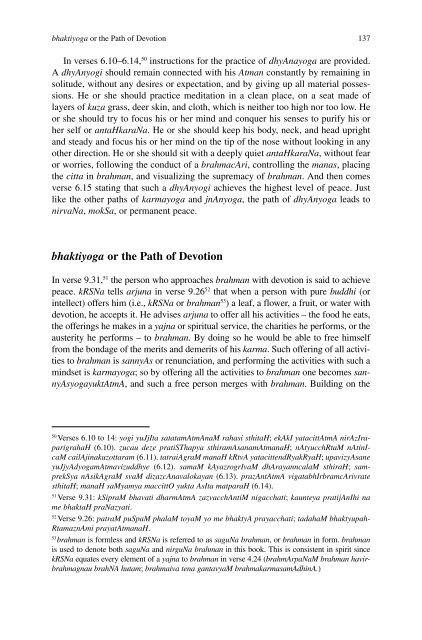Spirituality and Indian Psychology: Lessons from ... - Mandhata Global
Spirituality and Indian Psychology: Lessons from ... - Mandhata Global
Spirituality and Indian Psychology: Lessons from ... - Mandhata Global
You also want an ePaper? Increase the reach of your titles
YUMPU automatically turns print PDFs into web optimized ePapers that Google loves.
haktiyoga or the Path of Devotion<br />
In verses 6.10–6.14, 50 instructions for the practice of dhyAnayoga are provided.<br />
A dhyAnyogi should remain connected with his Atman constantly by remaining in<br />
solitude, without any desires or expectation, <strong>and</strong> by giving up all material possessions.<br />
He or she should practice meditation in a clean place, on a seat made of<br />
layers of kuza grass, deer skin, <strong>and</strong> cloth, which is neither too high nor too low. He<br />
or she should try to focus his or her mind <strong>and</strong> conquer his senses to purify his or<br />
her self or antaHkaraNa. He or she should keep his body, neck, <strong>and</strong> head upright<br />
<strong>and</strong> steady <strong>and</strong> focus his or her mind on the tip of the nose without looking in any<br />
other direction. He or she should sit with a deeply quiet antaHkaraNa, without fear<br />
or worries, following the conduct of a brahmacAri, controlling the manas, placing<br />
the citta in brahman, <strong>and</strong> visualizing the supremacy of brahman. And then comes<br />
verse 6.15 stating that such a dhyAnyogi achieves the highest level of peace. Just<br />
like the other paths of karmayoga <strong>and</strong> jnAnyoga, the path of dhyAnyoga leads to<br />
nirvaNa, mokSa, or permanent peace.<br />
bhaktiyoga or the Path of Devotion<br />
In verse 9.31, 51 the person who approaches brahman with devotion is said to achieve<br />
peace. kRSNa tells arjuna in verse 9.26 52 that when a person with pure buddhi (or<br />
intellect) offers him (i.e., kRSNa or brahman 53 ) a leaf, a flower, a fruit, or water with<br />
devotion, he accepts it. He advises arjuna to offer all his activities – the food he eats,<br />
the offerings he makes in a yajna or spiritual service, the charities he performs, or the<br />
austerity he performs – to brahman. By doing so he would be able to free himself<br />
<strong>from</strong> the bondage of the merits <strong>and</strong> demerits of his karma. Such offering of all activities<br />
to brahman is sannyAs or renunciation, <strong>and</strong> performing the activities with such a<br />
mindset is karmayoga; so by offering all the activities to brahman one becomes sannyAsyogayuktAtmA,<br />
<strong>and</strong> such a free person merges with brahman. Building on the<br />
50 Verses 6.10 to 14: yogi yuJjIta satatamAtmAnaM rahasi sthitaH; ekAkI yatacittAtmA nirAzIraparigrahaH<br />
(6.10). zucau deze pratiSThapya sthiramAsanamAtmanaH; nAtyucchRtaM nAtinIcaM<br />
cailAjinakuzottaram (6.11). tatraiAgraM manaH kRtvA yatacittendRyakRyaH; upavizyAsane<br />
yuJjyAdyogamAtmavizuddhye (6.12). samaM kAyazrogrIvaM dhArayanncalaM sthiraH; samprekSya<br />
nAsikAgraM svaM dizazcAnavalokayan (6.13). prazAntAtmA vigatabhIrbramcArivrate<br />
sthitaH; manaH saMyamya maccittO yukta AsIta matparaH (6.14).<br />
51 Verse 9.31: kSipraM bhavati dharmAtmA zazvacchAntiM nigacchati; kaunteya pratijAnIhi na<br />
me bhaktaH praNazyati.<br />
52 Verse 9.26: patraM puSpaM phalaM toyaM yo me bhaktyA prayacchati; tadahaM bhaktyupah-<br />
RtamaznAmi prayatAtmanaH.<br />
53 brahman is formless <strong>and</strong> kRSNa is referred to as saguNa brahman, or brahman in form. brahman<br />
is used to denote both saguNa <strong>and</strong> nirguNa brahman in this book. This is consistent in spirit since<br />
kRSNa equates every element of a yajna to brahman in verse 4.24 (brahmArpaNaM brahman havirbrahmagnau<br />
brahNA hutam; brahmaiva tena gantavyaM brahmakarmasamAdhinA.)<br />
137

















